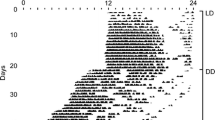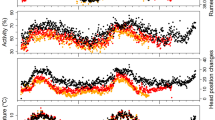Summary
The effects of restricted feeding schedules on the circadian rhythms of wheel-running of Dasyurus viverrinus were examined under a light/dark cycle and in constant darkness (experiment 1) and in constant light (experiment 2). The results of the 2 experiments showed that: (1) in contrast to the light/dark cycle, restricted feeding is only a weak zeitgeber for the wheel-running activity rhythms of D. viverrinus; (2) restricted feeding elicits meal anticipatory activity in D. viverrinus comparable to that elicited by restricted feeding in the rat; (3) transient cycles of the anticipatory activity free-run with a period different to that of the main component of activity for several cycles after the termination of restricted feeding; and (4) activity suggestive of beating between 2 oscillators occurs during restricted feeding and after the termination of restricted feeding. Taken together the latter 3 observations suggest that the activity rhythms of D. viverrinus are controlled by at least 2 separate circadian oscillators.
Similar content being viewed by others
References
Abe H, Kida M, Tsuji K, Mano T (1989) Feeding cycles entrain circadian rhythms of locomotor activity in CS mice but not in C57BL/6J mice. Physiol Behav 45:397–401
Albers HE, Gerall AA, Axelson JF (1981) Circadian rhythm dissociation in the rat: effects of long-term constant illumination. Neurosci Lett 25:89–94
Aschoff J, Goetz C von, Honma K (1983) Restricted feeding in rats: Effects of varying feeding cycles. Z Tierpsychol 63:91–111
Aschoff J, Goetz C von (1986) Effects of feeding cycles on the circadian rhythms in squirrel monkeys Saimiri sciureus. J Biol Rhythms 1:267–276
Blackhall S (1980) Diet of the eastern native cat Dasyurus viverrinus (Shaw), in southern Tasmania. Aust Widl Res 7:191–197
Bolles RC, Stokes LW (1965) Rat's anticipation of diurnal and adiurnal feeding. J Comp Physiol Psychol 60:290–294
Boulos Z, Terman M (1980) Food availability and daily biological rhythms. Neurosci Biobehav Rev 4:119–131
Boulos Z, Rosenwasser AM, Terman M (1980) Feeding schedules and the circadian organization of behaviour in the rat. Behav Brain Res 1:39–65
Boulos Z, Frim DM, Dewey LK, Moore-Ede MC (1989) Effects of restricted feeding schedules on circadian organization in squirrel monkeys. Physiol Behav 45:507–515
Clarke JD (1983) The role of food availability in the synchronisation of biological rhythms. Ph.D. thesis: La Trobe University, Melbourne
Clarke JD, Coleman GJ (1986) Persistent meal-associated rhythms in SCN-lesioned rats. Physiol Behav 36:105–113
Coleman GJ, Harper S, Clarke JD, Armstrong S (1982) Evidence for a separate meal-associated oscillator in the rat. Physiol Behav 29:107–115
Edmonds SC, Adler NT (1977a) Food and light as entrainers of circadian running activity in the rat. Physiol Behav 18:915–919
Edmonds SC, Adler NT (1977b) The multiplicity of biological oscillators in the control of circadian running activity in the rat. Physiol Behav 18:921–930
Fleay DH (1935) Breeding of Dasyurus viverrinus and general observations of the species. J Mammal 16:10–16
Gibbs FP (1979) Fixed interval feeding does not entrain the circadian pacemaker in blind rats. Am J Physiol 236:R249-R253
Godsell J (1982) The population ecology of the eastern quoll Dasyurus viverrinus (Dasyuridae, Marsupialia), in southern Tasmania. In: Archer M (ed) Carnivorous marsupials. R Zool Soc New South Wales, Sydney, Australia, 1982, pp 199–207
Green RH (1967) Notes on the devil (Sarcophilus harrisii) and the quoll (Dasyurus viverrinus) in northeastern Tasmania. Rec Queen Victoria Mus 27:1–13
Honma K, Goetz C von, Aschoff J (1983) Effects of restricted daily feeding on free-running circadian rhythms in rats. Physiol Behav 30:905–913
Jilge B, Hornicke H, Stahle H (1987) Circadian rhythms of rabbits during restrictive feeding. Am J Physiol 22:R46-R54
Kennedy GA, Coleman GJ, Armstrong SM (1990) Circadian rhythms of wheel-running in Dasyurus viverrinus. Australian Mammalogy, vol 13 (in press)
Krieger DT, Hauser H, Krey LC (1977) Suprachiasmatic nuclear lesions do not abolish food-shifted circadian adrenal and temperature rhythmicity. Science 197:398–399
Moore RY (1980) Suprachiasmatic nucleus, secondary synchronization stimuli and the central nervous system control of circadian rhythms. Brain Res 183:13–28
Moore-Ede MC, Sulzman FM, Fuller CA (1982) The clocks that time us. Harvard University Press, Cambridge London
Nelson JE, Smith G (1971) Notes on the growth rates in native cats of the family Dasyuridae. Int Zool Yearb 11:38–41
O'Reilly H, Armstrong SM, Coleman GJ (1986) Restricted feeding and circadian activity rhythms of a predatory marsupial, Dasyuroides byrnei. Physiol Behav 38:471–476
Phillips JLM, Milkulka PJ (1979) The effects of restricted food access upon locomotor activity in rats with suprachiasmatic nucleus lesions. Physiol Behav 23:257–262
Reid LS, Finger FW (1955) The rat's adjustment to 23-h food-deprivation cycles. J Comp Physiol Psychol 48:110–133
Richter CP (1922) A behaviouristic study of the activity of the rat. Comp Psychol Monogr 1:1–55
Ride WD (1970) Native animals of Australia. Oxford University Press, London
Rusak B, Zucker I (1979) Neural regulation of circadian rhythms. Physiol Rev 59:449–526
Scheving LE, Tsai TH, Scheving LA (1983) Chronobiology of the intestinal tract of the mouse. Am J Anat 168:433–465
Sharland M (1962) Tasmanian wildlife. Melbourne University Press, Melbourne
Stephan FK (1981) Limits of entrainment to periodic feeding in rats with suprachiasmatic lesions. J Comp Physiol 143:401–410
Stephan FK (1983) Circadian rhythm dissociation induced by periodic feeding in rats with suprachiasmatic lesions. Behav Brain Res 7:81–98, 1983
Stephan FK (1984) Phase shifts of circadian rhythms in activity entrained to food access. Physiol Behav 32:663–671
Stephan FK (1986a) The role of period and phase in interactions between feeding- and light-entrainable circadian rhythms. Physiol Behav 36:151–158
Stephan FK (1986b) Coupling between feeding- and light-entrainable circadian pacemakers in the rat. Physiol Behav 38:537–544
Stephan FK, Swann JM, Sisk CL (1979a) Anticipation of 24-h feeding schedules in rats with lesions of the suprachiasmatic nucleus. Behav Biol 25:346–363
Stephan FK, Swann JM, Sisk CL (1979b) Entrainment of circadian rhythms by feeding schedules in rats with suprachiasmatic lesions. Behav Neural Biol 25:545–554
Sulzman FM, Fuller CA, Moore-Ede MC (1977a) Environmental synchonizers of squirrel monkey circadian rhythms. J Appl Physiol 43:795–800
Sulzman FM, Fuller CA, Moore-Ede MC (1977b) Feeding time synchonizes primate circadian rhythms. Physiol Behav 18:775–779
Sulzman FM, Fuller CA, Moore-Ede MC (1978) Comparison of synchonization of primate circadian rhythms by light and food. Am J Physiol 234:R130-R135
Zielinski WJ (1986) Circadian rhythms of small carnivores and the effect of restricted feeding on daily activity. Physiol Behav 38:613–620
Author information
Authors and Affiliations
Rights and permissions
About this article
Cite this article
Kennedy, G.A., Coleman, G.J. & Armstrong, S.M. The effect of restricted feeding on the wheel-running activity rhythms of the predatory marsupial Dasyurus viverrinus . J Comp Physiol A 166, 607–618 (1990). https://doi.org/10.1007/BF00240010
Accepted:
Issue Date:
DOI: https://doi.org/10.1007/BF00240010




